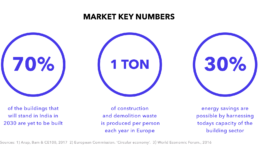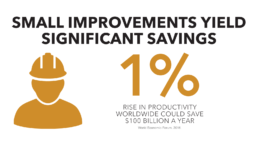As we build the world around us at ever-growing speed, the highly-emitting construction sector must adopt circular approaches and adapt to disruptive technologies in order to cut emissions. Upcycling waste into construction materials will result in a six-fold value increase, strengthening the industry’s foundations.
The construction industry accounts for 6% of global GDP and employs 100 million people worldwide. It is also the largest global consumer of raw materials, with constructed objects accounting for 25% to 40% of the world’s carbon emissions. Cement production, half of which occurs in China, represents almost 5% of all carbon emissions. These figures are likely to grow as construction keeps up with economic growth and urbanisation. The acceleration in construction is most evident in China, where more concrete was used between 2011 and 2013 than in the United States during the entire 20th century.
Despite being such a valuable and pervasive industry, the industry’s low-risk approach means that outdated techniques and economic inefficiencies are widespread. In the United States, for example, 40% of all solid waste comes from the construction industry, and globally, roughly a quarter of building materials deployed on site are wasted due to over-ordering. Reducing waste volumes and incorporating the remaining waste streams into circular models can unlock value for innovators and reduce the construction industry’s environmental impact. One example of such an approach is StoneCycling, which builds houses with bricks made from old construction waste – all sourced locally.

Products and Services
This opportunity brings a range of new products and services such as 3D printing of construction material. Winsun in China has demonstrated a process that can source 50% of the printing material from construction and mining waste. In addition, the process minimises waste in the construction process and reduces the overall material usage by up to 60% compared to traditional construction methods.
The “product as a service” concept is also growing in this sector, blurring the boundaries between products and services. Instead of selling the product itself, the benefits of the product are sold, with the provider retaining ownership and therefore responsibility for a product at the end of its life cycle. This can include anything from building materials that make up a structure, components for heating systems, or even electricity-generating photovoltaic cells.
Urban mining is another new service that arises from the circular approach to old buildings, with a focus on extracting existing raw materials from buildings scheduled for demolition or refurbishment. Studies have calculated that urban mining could deliver property developers returns of 10% on refurbishment investment.

Market Size and Demand Drivers
Global construction output is forecast to grow by 85% to $15.5 trillion by 2030, 57% of which is accounted for by China, the US, and India. International agreements and national strategies will be key drivers for ensuring future buildings fit into circular models. Additionally, there is a growing demand from architects and developers for new buildings to meet carbon neutrality standards. Although still small in scale, the 3D concrete printing market is estimated to grow from $24.5 million in 2015 to $56.4 million by 2021, at a CAGR of 15%.
This market featured in the 2018 Global Opportunity Report.

